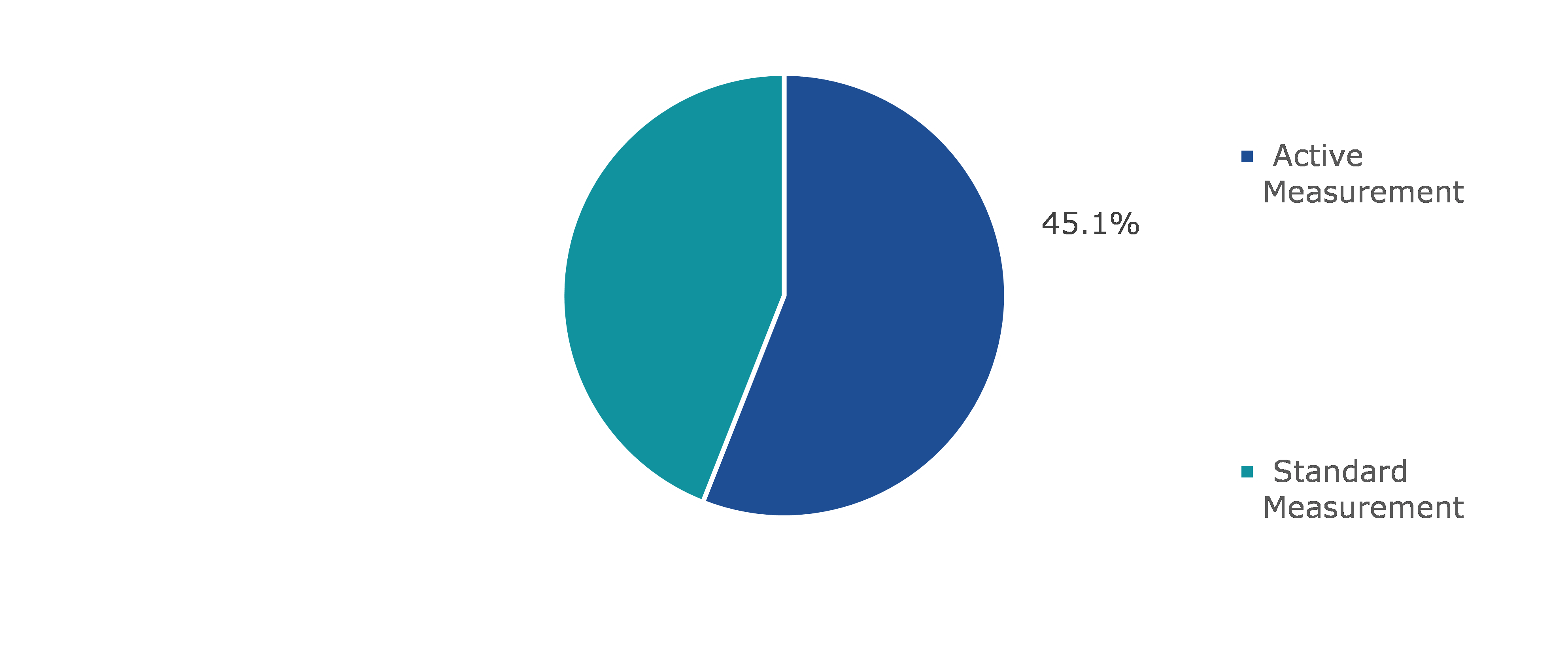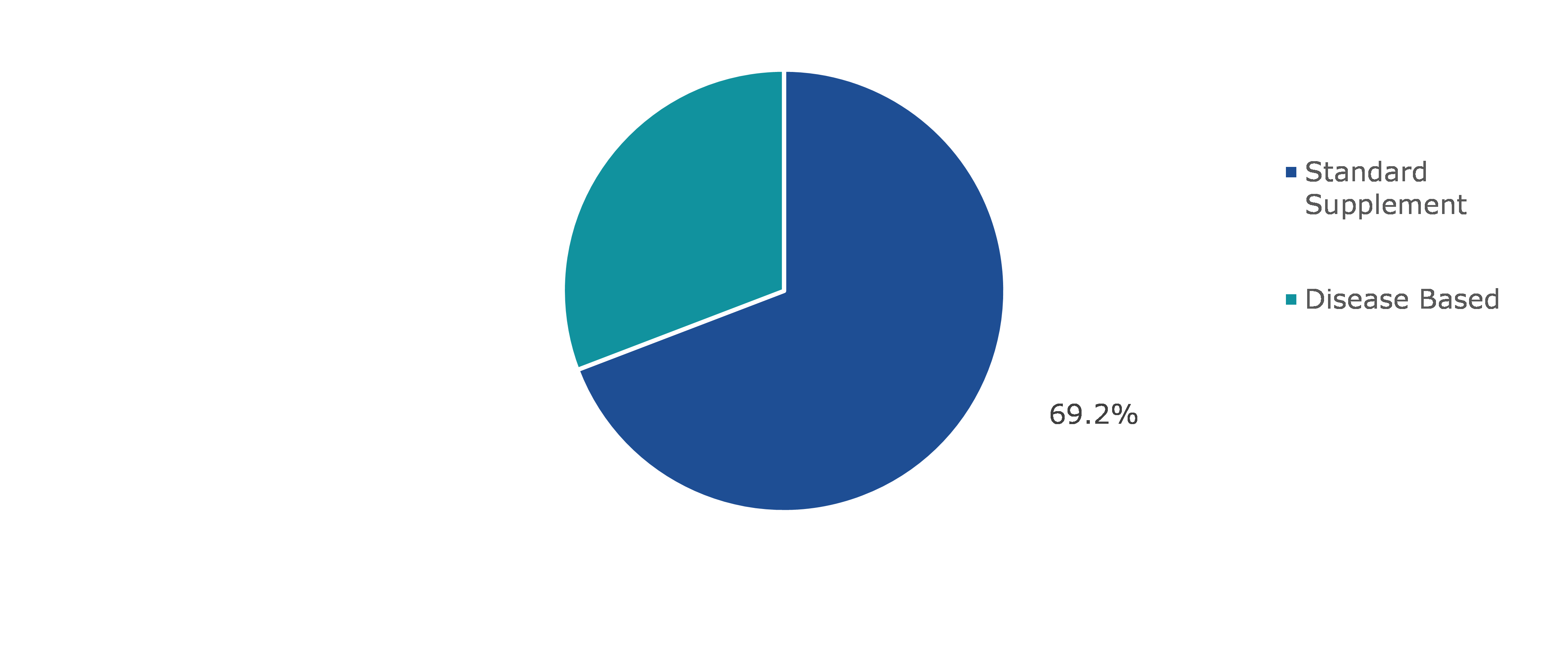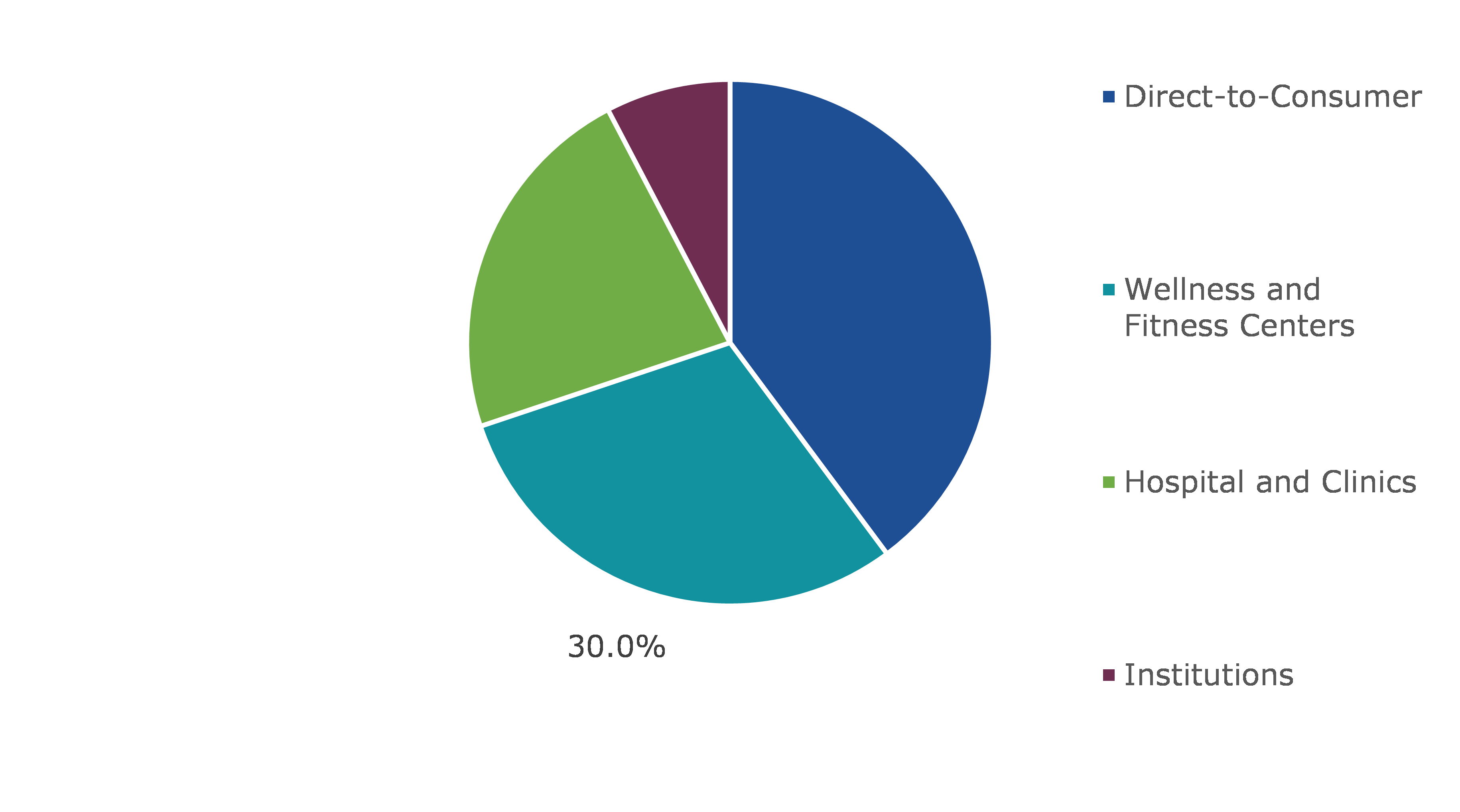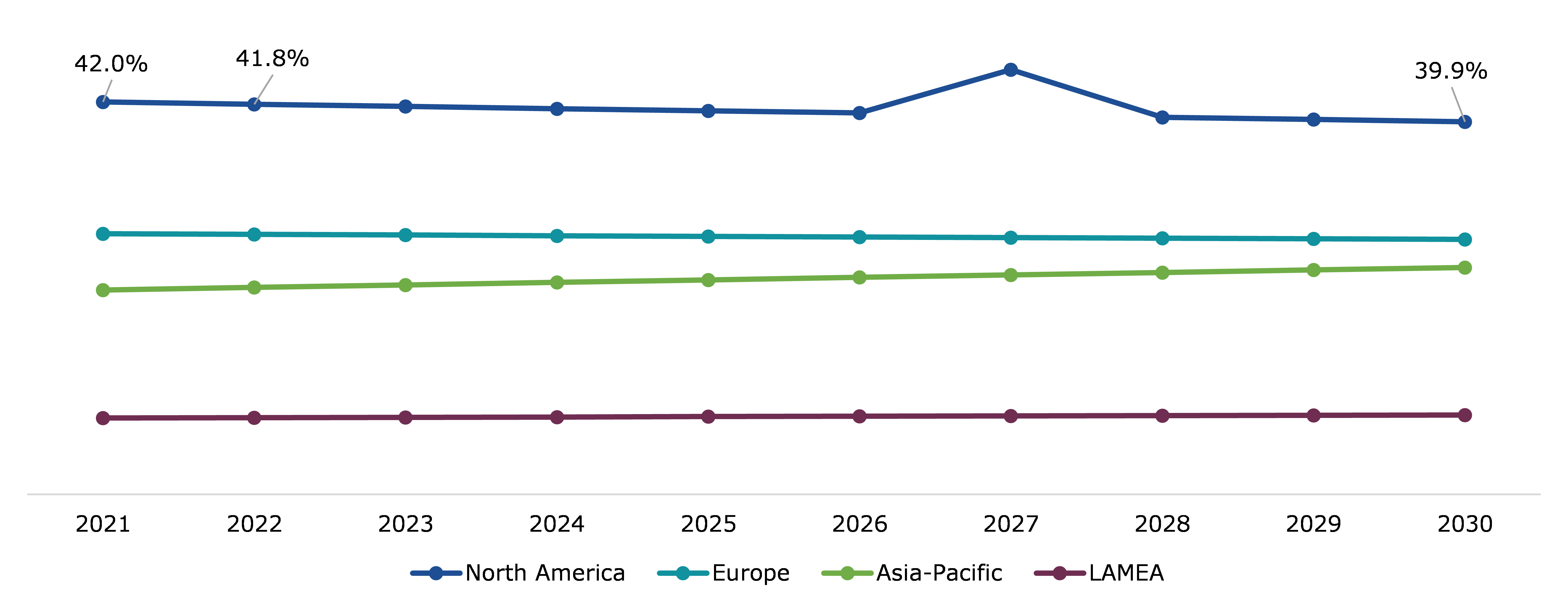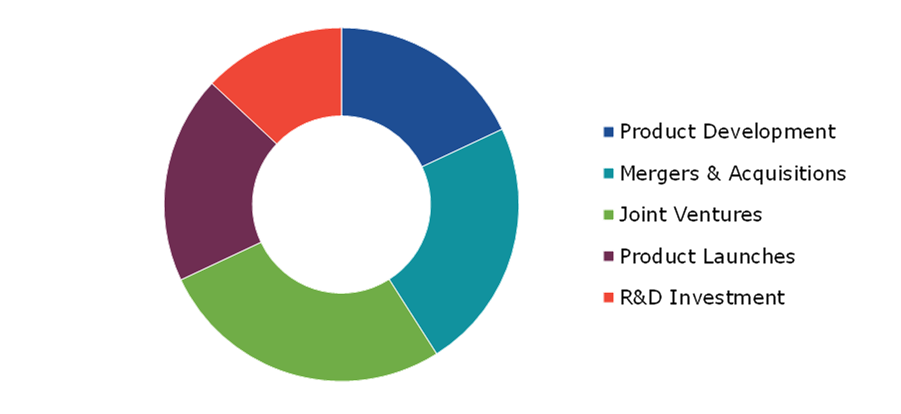Personalized Nutrition Market Report
RA04274
Personalized Nutrition Market by Product Type (Active Measurement and Standard Measurement), Application (Standard Supplement and Disease Based), End-use (Direct-to-consumer, Wellness & Fitness Centers, Hospital & Clinics, and Institutions), and Regional Analysis (North America, Europe, Asia-Pacific, and LAMEA): Global Opportunity Analysis and Industry Forecast, 2022–2030
Global Personalized Nutrition Market Analysis
The global personalized nutrition market is predicted to garner $37,286.9 million in the 2022–2030 timeframe, growing from $14,612.1 million in 2021, at a healthy CAGR of 11.48%.
Market Synopsis
Strategic alliances among market players, along with growing health concern is expected to accelerate the growth of the personalized nutrition market. The rising demand for personalized solutions as a result of rising health awareness, the strong trend of digitalization for healthcare, as well as the growing older population all over regions are among the major factors anticipated to pay to market growth over the forecast period. Furthermore, transferring demand patterns, such as a preference for highly nutritious food based on their nutritional content are anticipated to stimulate the growth of personalized nutrition approaches, contributing to market growth.
However, expensive personalized nutritionists along with lack of awareness might be growth-restricting factor for the market. Moreover, the high cost of dietary supplements and nutrition plans, as well as the complications associated with the approach, is expected to stymie market growth. Furthermore, the presence of regulations in the personalized nutrition sector is expected to be a challenge in the forecast period.
According to the regional analysis, the Asia-Pacific personalized nutrition market is anticipated to grow during the review period and generate a revenue of $9,060.7 million in 2030, with CAGR of 12.76%, due to increasing consciousness of consumers about the benefits of personalized nutrition.
Personalized Nutrition Overview
Almost every individual has different feature that responds to diet differently and it is mainly associated with the uniqueness of lifestyle, microbiome, and genetics. Personalized nutrition is the approach that gives guidelines for healthy diet plans, products, and services. Moreover, personalized nutrition is applicable for healthy person as well as patients.
Impact Analysis of COVID-19 on the Global Personalized Nutrition Market
Though the novel coronavirus pandemic had a devastating effect on several industries, the personalized nutrition market experienced a significant growth during this period. Most of the people are taking their health more seriously and adopting health diets during the lockdown imposed by the government to restrict the spread of the coronavirus disease. The coronavirus pandemic brought a great impact on the companies. As the health complications have increased, people have started opting for health supplements to increase their immunity, leading to the increased demand for personalized nutrition. Therefore, the importance of good health has skyrocketed, thus driving the growth of the market.
In addition to this, many companies in different countries have stepped forward to help other countries by offering personalized nutrition through online consultations. For instance, Amway, US based multi-level marketing company, announced in April 2021, that they have launched Nutrilite, vitamin C tablet that is made up of acerola cherry extract, which will support body’s natural defense system. It is specially formed with vitamin C and it gives quick response to the person. The above-stated factors show that the pandemic may generate substantial investment opportunities in the market in the coming years.
Increasing Prevalence of Customized Approaches for Nutrition to Surge the Market Growth
The growing popularity of receiving nutritional guidance based on individual needs is a major factor driving the personalized nutrition market. With an increasing number of obese and unhealthy people, as well as busy and unhealthy eating habits, personalized nutrition is expected to gain traction. Personalized nutrition is a diet that is recommended for meeting individual nutritional needs. Furthermore, personalized nutrition can reveal a complete history of a person's metabolism, environmental exposure, genetic profile, personal wellness goals, and microbiome composition. According to the American Nutrition Association, personalized nutrition is a field that can expose human individuality and enable the development of nutrition strategies for disease management, prevention, and treatment for healthy lifestyles. Furthermore, demand for conscious food choices, healthy lifestyles along with preventive health measures in the food sector is leading to the overall growth of personalized nutrition.
Equivalently, companies that are emerging in personalized nutrition industry are already leading market players to innovate strategies for customers. For example, in November 2019, Amway, US based multi-national company, announced that they have invested USD 200 million in China for the development of innovation center of dietary supplement. This innovation center helps in providing individuals customized solutions for personalized nutrition. These types of initiatives from market leaders are also predicted to drive the growth of the market.
To know more about global personalized nutrition market drivers, get in touch with our analysts here.
Higher Cost of Personalized Nutrition to Restrain the Market Growth
The personalized nutrition services are costly; therefore, they might be unaffordable by many people. This factor is expected to restrain the growth of the global market during the forecast period. Moreover, lack of awareness regarding how personalized nutrition helps in monitoring the health and treatment is one of the factors anticipated to hinder the market value of the personalized nutrition in the next few years.
Growing Technological Advancements in the Personalized Nutrition to Create Massive Investment Opportunities
The global personalized nutrition market is growing at a very fast pace therefore the researchers and scientists have paced up their research and development activities to develop latest technology devices for better use of personalized nutrition by customers. Use of artificial intelligence in personalized nutrition is one of the key factors that might create huge opportunities across the globe. Moreover, according to one of the articles by NCBI (National Center for Biotechnology Information), AI technologies have the potential to achieve personalized nutrition for human health. This technology will link the genomics for the improvement of health and pre diseases monitoring, thereby positively affecting the market growth.
Furthermore, personalized nutrition industry already has leading market players innovating strategies to attract customers. For instance, in February 2021, Bhookha Haathi, the Indian startup, announced that they have launched personalized health solutions that are based on AI. All the products that the company offers are fully organic ISO certified. All such aspects may further lead to lucrative market opportunities for key players in the upcoming years.
To know more about global personalized nutrition market opportunities, get in touch with our analysts here.
Global Personalized Nutrition Market, by Product Type
Based on product type, the market has been divided into active measurement and standard measurement sub-segments of which the active measurement sub-segment is projected to generate the maximum revenue as well as show the fastest growth.
Global Personalized Nutrition Market Share, By Product Type, 2021
Source: Research Dive Analysis
The active measurement type sub-segment is predicted to have a dominating share as well as be the fastest growing market share in the global market and register a revenue of $25,123.2 million during the forecast period. Active measurement refers to measurement tools such as testing kits, programmes, and apps. These tools are used to keep track of a customizable and accurate nutrient profile based on the needs of the individual. Furthermore, key market players are forming strategic alliances to provide customers with the best type of personalized nutrition. For example, DNAfit, a UK-based company, announced in April 2019, that they had launched health fit, a type of DNA test kit that will assist in exploring a person's nutritional needs and providing personalized diets. These factors, as well as strategic alliances formed by key companies may help the sub-segment grow during the forecast period.
Global Personalized Nutrition Market, by Application
On the basis of application, the market has been sub-segmented into standard supplement and disease based. Among the mentioned sub-segments, the disease based sub-segment is predicted to show the fastest growth and standard supplement garner a dominant market share.
Global Personalized Nutrition Market Share, By Application, 2021
Source: Research Dive Analysis
The disease based sub-segment of the global personalized nutrition market is projected to have the fastest growth and surpass $11,929.6 million by 2030, with an increase from $4,502.7 million in 2021. This market expansion can be attributed to the rising number of diseases worldwide. As a result, personalized nutrition assists patients in receiving prescribed or customized nutrition by scanning multi-factorial diseases using personalized tests. Furthermore, shifting to personalized nutrition can provide dietary advice that is specifically tailored to their genotype. All of these factors may increase demand for the sub-segment and accelerate market growth.
Global Personalized Nutrition Market, by End-use
On the basis of end-use, the market has been sub-segmented into direct-to-consumer, wellness & fitness centers, hospital & clinics, and institutions. Among the mentioned sub-segments, the wellness & fitness centers sub-segment is predicted to show the fastest growth and direct-to-consumer garner a dominant market share.
Global Personalized Nutrition Market Share, By End-use, 2021
Source: Research Dive Analysis
The wellness & fitness centers sub-segment of the global personalized nutrition market is projected to have the fastest growth in the market and surpass $11,566.0 million by 2030, with an increase from $4,387.7 million in 2021. The growth of the sub-segment is mainly attributed to increasing trends of health services such as nutrition consulting, personal training, and fitness center among people. Also, they offer various personalized nutrition solutions such as supplements, energy drinks, and protein powders that are customized fully according to the consumer’s preference. A wellness center is type of health service involving nutrition consulting, personal training, and fitness. Health services mostly includes mind, body, and skin care. Wellness and fitness centers offer various personalized nutrition solutions such as supplements, energy drinks, and protein powders that are customized fully according to the consumer preference. All such elements may increase the demand for wellness & fitness centers and further surge the market growth.
Global Personalized Nutrition Market, Regional Insights:
The personalized nutrition market was investigated across North America, Europe, Asia-Pacific, and LAMEA.
Global Personalized Nutrition Market Size & Forecast, By Region, 2021-2030 (USD Million)
Source: Research Dive Analysis
The Market for Personalized Nutrition in North America to be the Most Dominant
The North America personalized nutrition market accounted $6,137.1 million in 2021 and is projected to register a revenue of $14,877.5 million by 2030. The extensive growth of the North America personalized nutrition market is mainly driven by higher disposable incomes with existence of top leading companies augmenting the industry growth in the region. Moreover, the strong presence of leading personalized nutrition providers and manufacturers that offer trending personalized nutrition diets and tests is fueling the market growth across the globe. These factors will ultimately drive the demand in the personalized nutrition market across the region. The North America personalized nutrition market is driven by increasing number of obese people in the region. According to CDC (Centre of Disease Control and Prevention), in 2017–2018, US obesity predominance was 42.4%; that means 1 out every 3 people in US is. obese Also, hectic lifestyle is one of the factors that will encourage people for opting personalized nutrition in any form. In addition, the emergency of COVID-19 has strongly impacted the U.S. population; this factor has had direct impact on the adoption of personalized nutrition across the U.S. The demand for personalized nutrition has risen because people are taking vitamins, proteins, and mineral supplements for enhancing their immunity, which will also increase the adoption of personalized nutrition.
Competitive Scenario in the Global Personalized Nutrition Market
Product launches and mergers & acquisitions are common strategies followed by major market players.
Source: Research Dive Analysis
Some of the leading personalized nutrition market players are BASF SE, DSM, Herbalife Nutrition, Amway, DNAfit, Wellness Coaches, Atlas Biomed, Habit, LLC, Bactolac Pharmaceutical, and Balchem Corporation.
| Aspect | Particulars |
| Historical Market Estimations | 2020-2021 |
| Base Year for Market Estimation | 2021 |
| Forecast Timeline for Market Projection | 2022-2030 |
| Geographical Scope | North America, Europe, Asia-Pacific, LAMEA |
| Segmentation by Product Type |
|
| Segmentation by Application |
|
| Segmentation by End-use |
|
| Key Companies Profiled |
|
Q1. What is the size of the global personalized nutrition market?
A. The size of the global personalized nutrition market was over $14,612.1 million in 2021 and is projected to reach $37,286.9 million by 2030.
Q2. Which are the major companies in the personalized nutrition market?
A. DSM, Herbalife Nutrition, and Amway are some of the key players in the global personalized nutrition market.
Q3. Which region, among others, possesses greater investment opportunities in the near future?
A. The Asia-Pacific region possesses great investment opportunities for investors to witness the most promising growth in the future.
Q4. What will be the growth rate of the Asia-Pacific personalized nutrition market?
A. Asia-Pacific personalized nutrition market is anticipated to grow at 12.76% CAGR during the forecast period.
Q5. What are the strategies opted by the leading players in this market?
A. Technological development and strategic partnerships are the key strategies opted by the operating companies in this market.
Q6. Which companies are investing more on R&D practices?
A. DSM and Herbalife Nutrition are investing more on R&D activities for developing new products and technologies.
1.Research Methodology
1.1.Desk Research
1.2.Real time insights and validation
1.3.Forecast model
1.4.Assumptions and forecast parameters
1.5.Market size estimation
1.5.1.Top-down approach
1.5.2.Bottom-up approach
2.Report Scope
2.1.Market definition
2.2.Key objectives of the study
2.3.Report overview
2.4.Market segmentation
2.5.Overview of the impact of COVID-19 on Global personalized nutrition market
3.Executive Summary
4.Market Overview
4.1.Introduction
4.2.Growth impact forces
4.2.1.Drivers
4.2.2.Restraints
4.2.3.Opportunities
4.3.Market value chain analysis
4.3.1.List of raw material suppliers
4.3.2.List of manufacturers
4.3.3.List of distributors
4.4.Innovation & sustainability matrices
4.4.1.Technology matrix
4.4.2.Regulatory matrix
4.5.Porter’s five forces analysis
4.5.1.Bargaining power of suppliers
4.5.2.Bargaining power of consumers
4.5.3.Threat of substitutes
4.5.4.Threat of new entrants
4.5.5.Competitive rivalry intensity
4.6.PESTLE analysis
4.6.1.Political
4.6.2.Economical
4.6.3.Social
4.6.4.Technological
4.6.5.Environmental
4.7.Impact of COVID-19 on Personalized nutrition market
4.7.1.Pre-covid market scenario
4.7.2.Post-covid market scenario
5.Personalized Nutrition Market, by Product
5.1.Active Measurement
5.1.1.Market size and forecast, by region, 2022-2030
5.1.2.Comparative market share analysis, 2022 & 2030
5.2.Standard Measurement
5.2.1.Market size and forecast, by region, 2022-2030
5.2.2.Comparative market share analysis, 2022 & 2030
5.3.Research Dive Exclusive Insights
5.3.1.Market attractiveness
5.3.2.Competition heatmap
6.Personalized Nutrition Market, by Application
6.1.Standard Supplements
6.1.1.Market size and forecast, by region, 2022-2030
6.1.2.Comparative market share analysis, 2022 & 2030
6.2.Disease-Based
6.2.1.Market size and forecast, by region, 2022-2030
6.2.2.Comparative market share analysis, 2022 & 2030
6.3.Research Dive Exclusive Insights
6.3.1.Market attractiveness
6.3.2.Competition heatmap
7.Personalized Nutrition Market, by End-use
7.1.Direct-to-consumer
7.1.1.Market size and forecast, by region, 2022-2030
7.1.2.Comparative market share analysis, 2022 & 2030
7.2.Wellness and Fitness Centre
7.2.1.Market size and forecast, by region, 2022-2030
7.2.2.Comparative market share analysis, 2022 & 2030
7.3.Hospitals and Clinics
7.3.1.Market size and forecast, by region, 2022-2030
7.3.2.Comparative market share analysis, 2022 & 2030
7.4.Institutions
7.4.1.Market size and forecast, by region, 2022-2030
7.4.2.Comparative market share analysis, 2022 & 2030
7.5.Research Dive Exclusive Insights
7.5.1.Market attractiveness
7.5.2.Competition heatmap
8.Personalized Nutrition Market, by Region
8.1.North America
8.1.1.U.S.
8.1.2.Market size and forecast, by product, 2022-2030
8.1.3.Market size and forecast, by Application , 2022-2030
8.1.4.Market size and forecast, by End-use , 2022-2030
8.1.5.Canada
8.1.6.Market size and forecast, by product, 2022-2030
8.1.7.Market size and forecast, by Application , 2022-2030
8.1.8.Market size and forecast, by End-use , 2022-2030
8.1.9.Mexico
8.1.10.Market size and forecast, by product, 2022-2030
8.1.11.Market size and forecast, by Application , 2022-2030
8.1.12.Market size and forecast, by End-use , 2022-2030
8.1.13.Research Dive Exclusive Insights
8.1.13.1.Market attractiveness
8.1.13.2.Competition heatmap
8.2.Europe
8.2.1.Germany
8.2.2.Market size and forecast, by product, 2022-2030
8.2.3.Market size and forecast, by Application , 2022-2030
8.2.4.Market size and forecast, by End-use , 2022-2030
8.2.5.UK
8.2.6.Market size and forecast, by product, 2022-2030
8.2.7.Market size and forecast, by Application , 2022-2030
8.2.8.Market size and forecast, by End-use , 2022-2030
8.2.9.France
8.2.10.Market size and forecast, by product, 2022-2030
8.2.11.Market size and forecast, by Application , 2022-2030
8.2.12.Market size and forecast, by End-use , 2022-2030
8.2.13.Spain
8.2.14.Market size and forecast, by product, 2022-2030
8.2.15.Market size and forecast, by Application , 2022-2030
8.2.16.Market size and forecast, by End-use , 2022-2030
8.2.17.Italy
8.2.18.Market size and forecast, by product, 2022-2030
8.2.19.Market size and forecast, by Application , 2022-2030
8.2.20.Market size and forecast, by End-use , 2022-2030
8.2.21.Rest of Europe
8.2.22.Market size and forecast, by product, 2022-2030
8.2.23.Market size and forecast, by Application , 2022-2030
8.2.24.Market size and forecast, by End-use , 2022-2030
8.2.25.Research Dive Exclusive Insights
8.2.25.1.Market attractiveness
8.2.25.2.Competition heatmap
8.3.Asia Pacific
8.3.1.China
8.3.2.Market size and forecast, by product, 2022-2030
8.3.3.Market size and forecast, by Application , 2022-2030
8.3.4.Market size and forecast, by End-use , 2022-2030
8.3.5.Japan
8.3.6.Market size and forecast, by product, 2022-2030
8.3.7.Market size and forecast, by Application , 2022-2030
8.3.8.Market size and forecast, by End-use , 2022-2030
8.3.9.India
8.3.10.Market size and forecast, by product, 2022-2030
8.3.11.Market size and forecast, by Application , 2022-2030
8.3.12.Market size and forecast, by End-use , 2022-2030
8.3.13.Australia
8.3.14.Market size and forecast, by product, 2022-2030
8.3.15.Market size and forecast, by Application , 2022-2030
8.3.16.Market size and forecast, by End-use , 2022-2030
8.3.17.South Korea
8.3.18.Market size and forecast, by product, 2022-2030
8.3.19.Market size and forecast, by Application , 2022-2030
8.3.20.Market size and forecast, by End-use , 2022-2030
8.3.21.Rest of Asia Pacific
8.3.22.Market size and forecast, by product, 2022-2030
8.3.23.Market size and forecast, by Application , 2022-2030
8.3.24.Market size and forecast, by End-use , 2022-2030
8.3.25.Research Dive Exclusive Insights
8.3.25.1.Market attractiveness
8.3.25.2.Competition heatmap
8.4.LAMEA
8.4.1.Brazil
8.4.2.Market size and forecast, by product, 2022-2030
8.4.3.Market size and forecast, by Application , 2022-2030
8.4.4.Market size and forecast, by End-use , 2022-2030
8.4.5.Saudi Arabia
8.4.6.Market size and forecast, by product, 2022-2030
8.4.7.Market size and forecast, by Application , 2022-2030
8.4.8.Market size and forecast, by End-use , 2022-2030
8.4.9.UAE
8.4.10.Market size and forecast, by product, 2022-2030
8.4.11.Market size and forecast, by Application , 2022-2030
8.4.12.Market size and forecast, by End-use , 2022-2030
8.4.13.South Africa
8.4.14.Market size and forecast, by product, 2022-2030
8.4.15.Market size and forecast, by Application , 2022-2030
8.4.16.Market size and forecast, by End-use , 2022-2030
8.4.17.Rest of LAMEA
8.4.18.Market size and forecast, by product, 2022-2030
8.4.19.Market size and forecast, by Application , 2022-2030
8.4.20.Market size and forecast, by End-use , 2022-2030
8.4.21.Research Dive Exclusive Insights
8.4.21.1.Market attractiveness
8.4.21.2.Competition heatmap
9.Competitive Landscape
9.1.Top winning strategies, 2021
9.1.1.By strategy
9.1.2.By year
9.2.Strategic overview
9.3.Market share analysis, 2021
10.Company Profiles
10.1.BASF SE
10.1.1.Business overview
10.1.2.Financial performance
10.1.3.Product portfolio
10.1.4.Recent strategic moves & developments
10.1.5.SWOT analysis
10.2.DSM
10.2.1.Business overview
10.2.2.Financial performance
10.2.3.Product portfolio
10.2.4.Recent strategic moves & developments
10.2.5.SWOT analysis
10.3.Herbalife Nutrition
10.3.1.Business overview
10.3.2.Financial performance
10.3.3.Product portfolio
10.3.4.Recent strategic moves & developments
10.3.5.SWOT analysis
10.4.Amway
10.4.1.Business overview
10.4.2.Financial performance
10.4.3.Product portfolio
10.4.4.Recent strategic moves & developments
10.4.5.SWOT analysis
10.5.DNAfit
10.5.1.Business overview
10.5.2.Financial performance
10.5.3.Product portfolio
10.5.4.Recent strategic moves & developments
10.5.5.SWOT analysis
10.6.Wellness Coaches
10.6.1.Business overview
10.6.2.Financial performance
10.6.3.Product portfolio
10.6.4.Recent strategic moves & developments
10.6.5.SWOT analysis
10.7.Atlas Biomed
10.7.1.Business overview
10.7.2.Financial performance
10.7.3.Product portfolio
10.7.4.Recent strategic moves & developments
10.7.5.SWOT analysis
10.8.Habit, LLC
10.8.1.Business overview
10.8.2.Financial performance
10.8.3.Product portfolio
10.8.4.Recent strategic moves & developments
10.8.5.SWOT analysis
10.9.Bactolac Pharmaceutical
10.9.1.Business overview
10.9.2.Financial performance
10.9.3.Product portfolio
10.9.4.Recent strategic moves & developments
10.9.5.SWOT analysis
10.10.Balchem Corporation
10.10.1.Business overview
10.10.2.Financial performance
10.10.3.Product portfolio
10.10.4.Recent strategic moves & developments
10.10.5.SWOT analysis
11.Appendix
11.1.Parent & peer market analysis
11.2.Premium insights from industry experts
11.3.Related reports
The eating habits of every individual respond in a unique way depending on the unique gene, microbiome, and lifestyle. Personalized nutrition approach offers guidelines to individuals to choose the perfect diets for their individual health. Personalized nutrition is also applicable for patients as much as for healthy individuals.
People in this era are living a busy lifestyle, resulting in poor eating habits and diet plans. By following personalized nutrients anyone can fulfil their personal nutritional requirements. Personalized nutrition is the field that can represent human individuality and outgrow the nutrition strategies that manage, prevent, and treat diseases for healthy lifestyles, as per a statement made by the American Nutrition Association. In addition, personalized nutrition helps in demystifying the impact of nutritional, genetic, biochemical, and phenotypic aspects of the individual’s health. This is main factor contributing to the rising popularity of personalized nutrition.
Impact Analysis of COVID-19 on the Personalized Nutrition Market
The coronavirus pandemic has had a drastic effect on the global economy as well as the industries. Many industries were permanently shut down while others are still struggling to revive from the financial loss. However, the personalized nutrition market has experienced a significant growth during the pandemic.
During the pandemic, people have become more conscious about the food choices and eating habits in order to strengthen their immunity. They are opting for health supplements and support of personalized nutrition. Apart from this, many companies are offering online consultation to the people and supporting them to choose their personalized nutrition during the pandemic. These factors are enhancing the market growth during the pandemic period.
Personalized Nutrition Market Trends and Developments
According to recent report published by Research Dive, the topmost players of the global personalized nutrition market include DSM, BASF SE, Herbalife Nutrition, DNAfit, Amway, Wellness Coaches, Habit, LLC, Atlas Biomed, Balchem Corporation, and Bactolac Pharmaceutical.
These industry players are investing a lot of efforts on the research and development of smart and unique strategies to sustain the growth of the market. These strategies include product launches, mergers and acquisitions, collaborations, partnerships, and refurbishing of existing technology. Some of the recent developments in the personalized nutrition market are as follows:
- In March 2019, Herbalife Nutrition, a premier global nutrition company, announced the launch of Formula 1 Select Meal Replacement shake & Protein Drink Mix Select. The two novel plant-based nutrition mixes are formulated with a high-quality blend of pea, rice and quinoa proteins, and are the perfect nutritional solution for those with common food allergies like dairy, soy, or gluten.
- In July 2021, Wellness Coaches, the global leader in health, safety, and wellbeing in the workplace, completed its strategic acquisition of Benovate, a next-gen digital health and wellness for the workplace. Wellness Coaches also launched its updated version of Healthy Ways platform with the integration of Benovate’s patented technology which will help offer real-time, personalized wellness experience to employees.
- In September 2021, DSM, a global purpose-led, science-based company, broadcasted about its calculated decision that it will focus entirely on its resources and competencies to address the burning societal and environmental issues and how it is connected to the way the world produces and consumes food.
Forecast Analysis of Global Market
The global personalized nutrition market is projected to witness an exponential growth over the forecast period, owing to the growing R&D activities and technological advancements in personalized nutrition. Conversely, the lack of awareness and high costs associated with personalized nutrition are expected to hamper the market growth in the projected timeframe.
The increasing popularity of receiving nutritional guidance based on individual needs and the rising number of obese and unhealthy people across the globe are the significant factors and personalized nutrition market trends estimated to bolster the growth of the global market in the coming future. According to a latest report published by Research Dive, the global personalized nutrition market is expected to garner $37,286.9 million during the forecast period (2022-2030). Regionally, the North America personalized nutrition market is estimated to observe lucrative growth by 2030, owing to the higher disposable incomes along with the existence of leading personalized nutrition manufacturers and providers in the region.
Personalize this research
- Triangulate with your own data
- Request your format and definition
- Get a deeper dive on a specific application, geography, customer or competitor
- + 1-888-961-4454 Toll - Free
- support@researchdive.com


